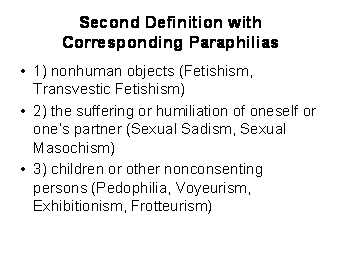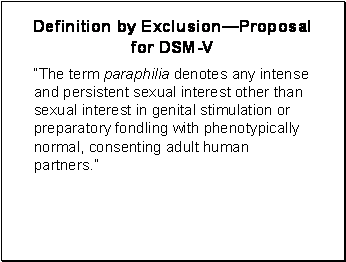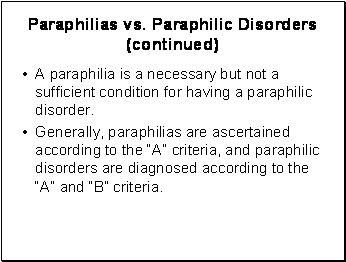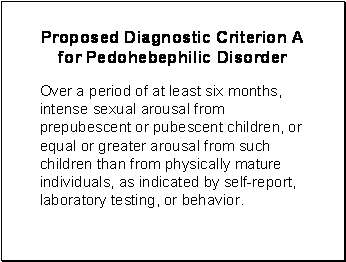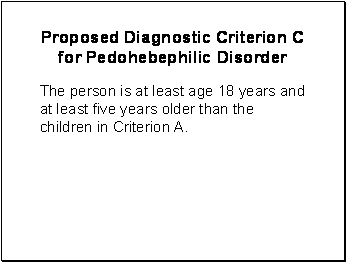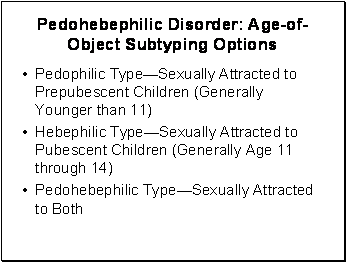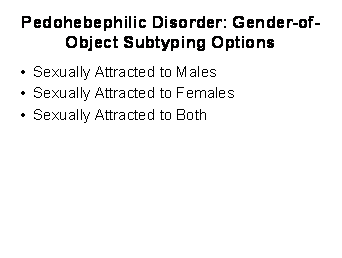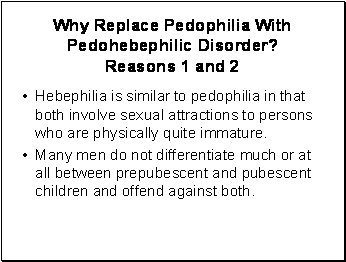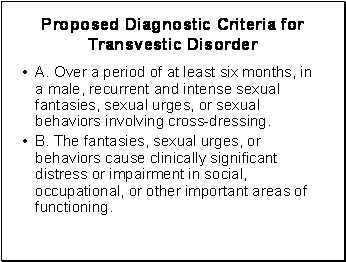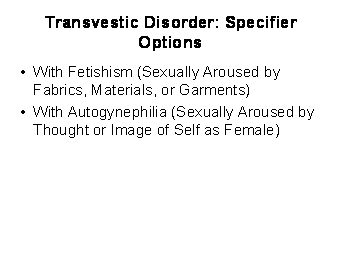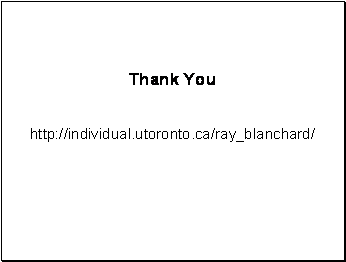|
DSM-V Options:
Paraphilias and Paraphilic Disorders, Pedohebephilic Disorder, and
Transvestic Disorder |
Paper presented at the 28th
Annual Meeting of the Association for the Treatment of Sexual Abusers,
October 1, 2009, |
|
SLIDE 1
|
Good afternoon. As the first
speaker, I want to lead off with certain matters pertaining to all the
paraphilias. After that, I will begin the discussion of specific paraphilias
with my comments on pedophilia and transvestism. It is important for me to
stress that I am presenting options for possible changes to the DSM. The
diagnostic criteria and text that ultimately appear in print could bear
little or no relation to the possibilities that I am about to show you. This presentation covers numerous
wording issues. For people who want to study these issues at their leisure, I
plan to put a verbatim copy of this talk on my Website after I return to |
|
SLIDE 2
|
I will now start with the
cross-cutting issues. The DSM-IV-TR does not give a precise definition of paraphilia, and it does not even
consistently use a single loose definition. The first definition occurs on
page 535. This definition has serious
drawbacks. The only attribute that makes a sexual desire eligible for
classification as a paraphilia is that it is unusual. This would include homosexuality, which is statistically
unusual but is no longer considered a paraphilia. The definition also implies
that one cannot have a paraphilia unless one is distressed or impaired by
that paraphilia. |
|
SLIDE 3
|
A different definition occurs
later on page 566. One might call this a definition by concatenation. It is
really not so much a definition as a table of contents for the DSM’s section
on paraphilias. This can be seen in Slide 4, where I have simply added to the
list of numbered categories the coded DSM paraphilias to which they
correspond. |
|
SLIDE 4
|
In practice, the definition by
concatenation would be of limited use to clinicians or researchers in
deciding whether a novel phenomenon is a paraphilia. I can illustrate this
with klismaphilia, the erotic
interest in having enemas, which is listed in the DSM-IV-TR as an example of
a Paraphilia Not Otherwise Specified. Enemas do involve nonhuman
objects, but these do not appear to be the focus of the experience. There is
no reason to assume that enemas are experienced as painful or humiliating to
the practitioners, and sexually motivated enemas do not involve nonconsenting
persons. Thus, klismaphilia would not be identifiable as a paraphilia using
the DSM’s second definition of paraphilia. In other words, a clinician using
the definition on p. 566 would not be able to identify klismaphilia as a
paraphilia, even though the DSM itself lists klismaphilia as an example of a
Paraphilia NOS! |
|
SLIDE 5
|
I have tried to avoid the problems
with the DSM-IV-TR’s definitions of paraphilia with a formulation that I have
called the definition by exclusion. This definition is not watertight.
It has, for example, been misread as classifying masturbation as a paraphilia.
I think it is better than no real definition, which is what the DSM-IV-TR
currently has, but I am still listening to suggestions for improvements. |
|
SLIDE 6
|
The next question is equally or
more important than the general definition of paraphilia. That is, are all
paraphilias ipso facto psychiatric
disorders? Our subgroup is taking the position that they are not. We are proposing that the DSM-V
make a distinction between paraphilias
and paraphilic disorders. A
paraphilia by itself would not automatically justify or require psychiatric
intervention. The general notion that we are
considering is shown on Slide 6. The first bulleted sentence shows that only
problematic paraphilias would be called paraphilic disorders. To underscore
that point, we propose to use the verb ascertain
when talking about paraphilias and the verb diagnose when talking about paraphilic disorders. |
|
SLIDE 7
|
Slide 7 shows how the distinction
would play out in DSM-V. As the screen shows, a paraphilia would be a
necessary but not a sufficient condition for a paraphilic disorder. The second bulleted point refers
to the general layout of the diagnostic criteria for the various paraphilias
in the DSM. The A criterion is
about identifying the phenomenon and the B
criterion is about distress and impairment. This approach leaves intact the
distinction between normative and non-normative sexual behavior, which could
be important to researchers, but without automatically labeling non-normative
sexual behavior as psychopathological. As with the general definition of
paraphilia, we have been looking closely at feedback from multiple sources
regarding this idea. This change would also eliminate
certain logical absurdities in the DSM-IV-TR. In this version, for example, a
man cannot be classified as a transvestite—however much he cross-dresses and
however sexually exciting that is to him—unless he is he is unhappy about
this activity or impaired by it. |
|
SLIDE 8
|
I am now going to turn from
matters that apply to all the paraphilias to my proposals for two specific
paraphilias. The first of these is presently called pedophilia. The first
thing you will notice is that I have proposed changing the name of the entity
from Pedophilia to Pedohebephilic Disorder. You will, of course, want to know
the meaning of the word “Pedohebephilic.” This is a compound of two words:
pedophilic and hebephilic. Pedophilia,
as classically defined by Krafft-Ebing and as still defined in the DSM,
denotes sexual attraction to prepubescent children. The word hebephilia, which was coined in the 1950’s, denotes sexual
attraction to pubescent children. There are many men who appear sexually
attracted to both pubescent and prepubescent children, and these have been
called pedohebephiles. My suggested
change in terminology, therefore, signals that I am proposing to expand the
diagnostic category to include men who are sexually attracted to pubescent
children as well as those attracted to prepubescent children. I will explain
my reasons for this later. First, I want to go over the proposed diagnostic
criteria. Slide 8 shows that the A
criterion—the ascertainment criterion—specifies the nature of the paraphilia,
namely, strong or preferential sexual attraction to prepubescent or pubescent
children. The reference to “laboratory testing” is meant to include tests
that might be developed in the future, such as fMRI ascertainment of
pedohebephilia. |
|
SLIDE 9
|
The B criterion is the distress
and impairment criterion. Criminal sexual offenses against children are
treated as de facto impairment. The clauses pertaining to number
of different victims may be understood as follows: Suppose that the patient is
assigned 1 point for each pubescent victim and 1.5 points for each
prepubescent victim. Then Criterion B is satisfied if the patient has accrued
a total of 3 points or higher. |
|
SLIDE 10
|
Previous versions of the DSM have
also included a C criterion, to
avoid labeling peer-appropriate sexual interest as paraphilic. I have done
the same, although the Subworkgroup has proposed increasing the age cut-off
from 16 to 18 years. |
|
SLIDE 11
|
I am also proposing two groups of
subtyping options. The first group of subtypes is shown on this screen—it
would be used to record the ages of children who are most attractive to the
patient. This would make it possible to identify classic pedophiles, through the
use of the first subtype. In fact, I believe that the first subtype would do
a better job of identifying classic pedophiles than the current DSM
diagnostic criteria for pedophilia. |
|
SLIDE 12
|
The second group of subtypes is
identical to that in the current version of the DSM. This group of subtypes
would be used the record the gender of children who are most attractive to
the patient. |
|
SLIDE 13
|
I promised earlier that I would
explain why I have suggested replacing Pedophilia with Pedohebephilic
Disorder. There are four reasons, which are shown on this slide and the next slide. The first and second reasons are
that the two entities are not completely different, and that many patients are
both pedophilic and hebephilic. |
|
SLIDE 14
|
The third reason is that patients
who are hebephilic are getting DSM diagnoses anyway—just not the most precise
ones. The
fourth reason is that this modification would help to harmonize the DSM and
the International Classification of Diseases published by the
World Health Organization. The ICD-10 already implicitly recognizes the
mismatch between the classical, narrow definition of pedophilia as sexual
attraction to prepubescent children and the clinical reality. |
|
SLIDE 15
|
The other specific paraphilia that
I will discuss was previously called Transvestic
Fetishism. I have proposed changing its name to Transvestic Disorder. In this option, the A and B criteria are
mostly similar to those in DSM-IV-TR. |
|
SLIDE 16
|
The main change I have proposed is
in the specifiers, which are shown on Slide 16. I made this recommendation
according to the results of research that I conducted specifically for the
Paraphilias Subworkgroup. The results showed that
transvestic patients who acknowledged autogynephilia had higher odds of
reporting past or current desires for sex reassignment than transvestic
patients who denied autogynephilia. The opposite result was found for
fetishism, that is, transvestites who reported fetishism were less likely to
report a desire for sex reassignment. It is noteworthy that these predictors
were independent to a large extent. |
|
SLIDE 17
|
I realize that the amount of time
allocated for this talk and questions was not enough for the topic. As I said
earlier, I plan to put the text on my Website after I get back to |



